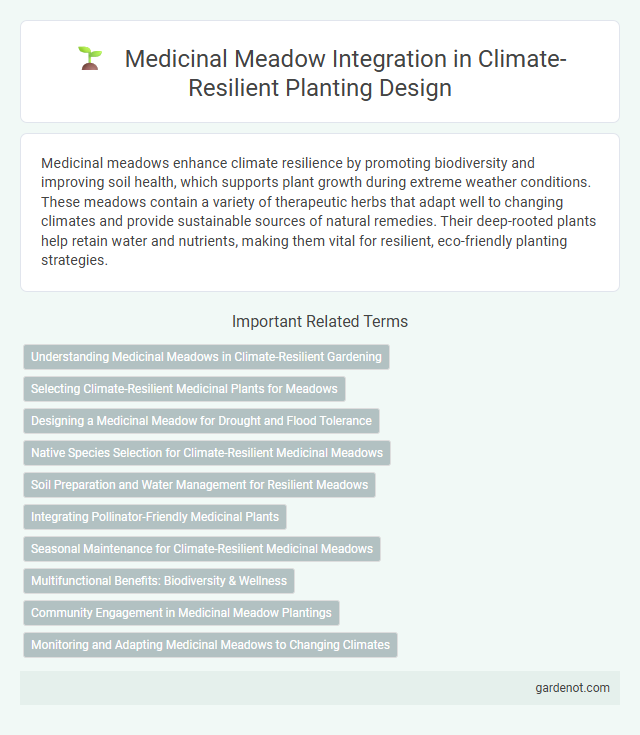Medicinal meadows enhance climate resilience by promoting biodiversity and improving soil health, which supports plant growth during extreme weather conditions. These meadows contain a variety of therapeutic herbs that adapt well to changing climates and provide sustainable sources of natural remedies. Their deep-rooted plants help retain water and nutrients, making them vital for resilient, eco-friendly planting strategies.
Understanding Medicinal Meadows in Climate-Resilient Gardening
Medicinal meadows enhance climate resilience by promoting biodiversity and supporting native plant species adapted to local conditions, which improve soil health and water retention. These meadows serve as natural habitats for pollinators essential in maintaining ecosystem balance and enhancing plant productivity amid changing climates. Integrating medicinal meadows into gardens strengthens ecological networks, ensuring sustainable and resilient plant growth in variable weather patterns.
Selecting Climate-Resilient Medicinal Plants for Meadows
Selecting climate-resilient medicinal plants for meadows involves prioritizing species with proven tolerance to drought, heat, and variable precipitation to ensure sustainable growth under changing climate conditions. Native plants such as Echinacea purpurea, Calendula officinalis, and Hypericum perforatum exhibit strong adaptability and provide valuable therapeutic properties while supporting local biodiversity. Integrating these resilient species enhances meadow stability, promotes ecosystem services, and secures the long-term availability of medicinal resources.
Designing a Medicinal Meadow for Drought and Flood Tolerance
Designing a medicinal meadow for drought and flood tolerance involves selecting hardy native plant species such as Echinacea purpurea and Achillea millefolium, known for their resilience and medicinal properties. Incorporating deep-rooted perennials improves soil structure and enhances water retention during dry periods, while species like Mentha arvensis can withstand occasional flooding. Strategic soil amendments and contouring further optimize moisture regulation, ensuring sustained growth and therapeutic yield in variable climate conditions.
Native Species Selection for Climate-Resilient Medicinal Meadows
Selecting native species for medicinal meadows enhances climate resilience by ensuring plants are well-adapted to local environmental conditions and stressors. Native medicinal plants exhibit higher survival rates during droughts and temperature fluctuations, supporting ecosystem stability and continuous availability of therapeutic compounds. Incorporating a diverse array of indigenous species promotes genetic diversity, which is crucial for adaptive capacity in shifting climates.
Soil Preparation and Water Management for Resilient Meadows
Medicinal meadows require well-prepared soil with high organic matter and proper aeration to promote deep root growth and drought resilience. Effective water management involves mulching to retain soil moisture and installing drip irrigation systems that minimize water loss while supporting plant health. These practices enhance the meadow's capacity to withstand climate stress and sustain medicinal plant productivity.
Integrating Pollinator-Friendly Medicinal Plants
Integrating pollinator-friendly medicinal plants in climate-resilient planting enhances biodiversity by supporting essential pollinators such as bees and butterflies. Medicinal meadows featuring species like Echinacea, Calendula, and Lavender not only provide ecological benefits but also offer therapeutic properties valuable for natural health remedies. These plants contribute to soil stability and water retention, making them vital components in adapting landscapes to changing climate conditions.
Seasonal Maintenance for Climate-Resilient Medicinal Meadows
Seasonal maintenance of climate-resilient medicinal meadows involves strategic mowing and selective weeding to promote native plant diversity and prevent invasive species. Timing these activities to coincide with plant life cycles enhances medicinal compound potency and supports pollinator habitats. Regular soil health assessments and adaptive management practices ensure the meadow's resilience to climate variability and sustained ecological function.
Multifunctional Benefits: Biodiversity & Wellness
Medicinal meadows enhance biodiversity by providing diverse habitats for pollinators, insects, and wildlife, promoting ecosystem resilience. The variety of native medicinal plants supports natural wellness through the production of therapeutic compounds used in herbal remedies and traditional medicine. This multifunctional approach combines ecological restoration with health benefits, making medicinal meadows vital for climate-resilient landscapes.
Community Engagement in Medicinal Meadow Plantings
Community engagement in medicinal meadow plantings fosters local stewardship and promotes biodiversity conservation by involving residents in hands-on planting and maintenance activities. Educational workshops and collaborative decision-making enhance awareness of native medicinal plants' ecological and therapeutic values, strengthening cultural connections and sustainable harvesting practices. This participatory approach supports climate resilience by building adaptive capacity through knowledge sharing and diverse plant selection tailored to local environmental conditions.
Monitoring and Adapting Medicinal Meadows to Changing Climates
Monitoring medicinal meadows involves regular assessment of soil moisture, plant health, and biodiversity to detect climate-induced stressors early. Adaptive management includes selecting heat-tolerant and drought-resistant medicinal plant species, adjusting planting schedules, and implementing water conservation techniques to sustain ecological balance. Integrating local climate data with traditional knowledge supports resilience and enhances the medicinal meadow's long-term productivity and therapeutic value.
Medicinal meadow Infographic

 gardenot.com
gardenot.com